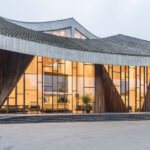To celebrate the opening of our 4th Annual A+Awards, we’re taking a look back at some of our favorite projects from 2015. Want to get in on the action? Check out the A+Awards Page to find out how to enter.
On September 22, we officially announced the Fourth Annual A+ Awards, the largest awards program focused on promoting and celebrating the year’s best architecture and products. With that announcement, we’re taking a step back to reflect on the program and a few of last year’s innovative submissions. With over 90 categories, projects were entered across a range of typologies, programs, and material assemblies. Over 200,000 votes were cast, and winning designs emerged from firms and designers worldwide. A panel of 300 judges choose one winner in each category, while the web community selected Popular Choice winners. Looking back at last year’s top projects, we couldn’t help but notice a common theme we couldn’t get enough of: faceted façades.
Expanding on our previous feature on facets, we’ve rounded up designs that wowed last year’s jury and public alike. Angular, pointed, and gem-like, these geometric projects were chosen across seven countries and diverse categories. Establishing bold formal and material narratives within their contexts, the structures tower above nearby skylines, create textured boundaries, and add dimension to traditionally flat faces. Trading nuance for expression, the designs explore new approaches to creating faceted envelopes and triangulated surfaces.

© Helen & Hard

© Helen & Hard
Rundeskogen by Helen & Hard, Sandnes, Norway
This faceted housing building was the jury’s winning selection for the Multi-Unit Housing – High Rise (16+ Floors) category. Sited at a node that links three cities across Norway, the project balanced a tall form with public green spaces. With over 100 apartment units and flats, Rundeskogen was both cantilevered and lifted from the ground to minimize its footprint.

© CUAC Arquitectura, Jose Luis Muñoz Muñoz

© CUAC Arquitectura, Jose Luis Muñoz Muñoz
Biodiversity Center by Jose Luis Muñoz Muñoz and pulido+piriz (CUAC), Granada, Spain
The Biodiversity Center won the Popular Vote for last year’s Office – Low Rise (1- 4 Floors) category. With close proximity to a great preexisting tree on site, the design aimed to merge landscape and architecture through a sloped, angular façade and roof space. The project’s two programmatic zones were created around concepts of publicity and protection of agricultural beliefs.

© Robert A. M. Stern Architects

© Peter Aaron/Esto
Tour Carpe Diem by Robert A. M. Stern Architects, Hauts-de-Seine, IDF, France
Located along the axis of the Champs-Elysées, the Tour Carpe Diem was designed to champion environmentally responsible architecture and pedestrian-friendly urbanism. Reflecting a “dual orientation and catching the ever-changing Parisian light,” the project’s faceted façade was created to form a strong identity among the towers of La Défense.

© HDR

© HDR
Wollongong Central Development by HDR, Wollongong, Australia
HDR’s Wollongong Central Development won both the Popular Vote and jury selection in last year’s A+ Awards for the Shopping Centers category. Created to fuse culture, art, and architecture, the five-story building connects two parts of the city by forming a “Public Street.” A carefully engineered outer shell unfolds to an organic interior with a façade designed to evoke the cliffs along the nearby coastline.

© Tim Griffith

© Tim Griffith
Jinao Tower by Skidmore, Owings & Merrill LLP ( SOM ), Nanjing, China
The Jinao Tower by SOM uses diagonal bracing to define an integrated and faceted envelope. A secondary glass façade defines a cavity to contain this structure, while also helping the tower respond to the city’s extreme heat. Combining opaque and translucent screens, the design focuses light down through a large atrium space.

© Tuomas Uusheimo Photography

© Tuomas Uusheimo Photography
Kuopio City Theatre by ALA Architects, Kuopio, Finland
This theater renovation project utilizes a simple, white rectangular volume to complement the existing structure on site. The building was clad in white fiber panels with a faceted, or wrinkled, surface form to attract the public inside.


Science Pyramid by BURKETTDESIGN, Denver, Colo., United States
Winner of the Denver Botanic Garden’s state-wide competition, the Science Pyramid was designed around biomimicry. Conceptually, the building was created to evoke ideas of shifting tectonic plates and intricate honeycombs. The façade was made to appear as if it’s emerging as a geological phenomenon from the landscape, a shell with advanced technological systems and hexagonal patterns.









